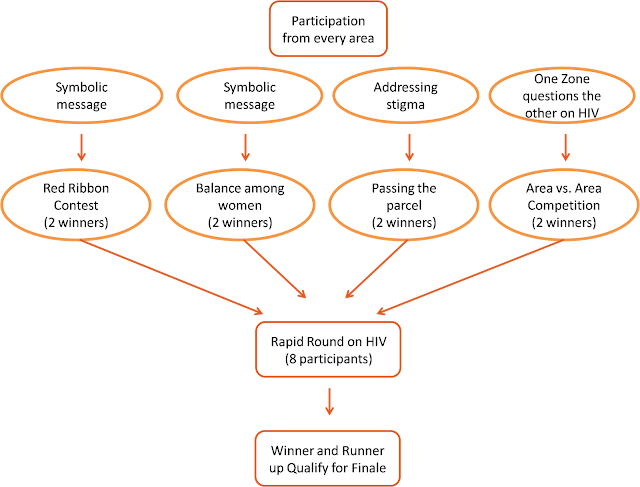The Grand Finale to the World AIDS Day 2011 was celebrated in a grandiose manner at the MDACS compound. A number of events were conducted there and prizes distributed for the same. There were games, plays, quiz competition, music and dance and an exhibition too.
GROUND EVENTS
Game 1: Pinning the Red Ribbon
This game had 8 participants and 4 rounds. Each round had two women participants competing against each other; they were given a basketful of red-ribbons which they had to pin on the women in the audience, in the shortest span of time. Out of a total of 8 participants, 2 were declared winners. The message of the game was - by pinning the red ribbon one was taking responsibility and spreading awareness about HIV/AIDS.
Game 2: Balancing the Basket
Four participants had to balance a basket on their heads and race a short distance. The message here was “the need to balance” their life to “stay protected” from HIV.
 |
| Audience |
Game 3: Choose the correct partner
16 women were given a chit each with the name of an animal, and by making the sound of it, each participant had to look for her ‘pair’. The message here was the “need to look for and stay faithful” to the “right partner”.
Game 4: Passing the parcel
Instead of passing any parcel, participants had to touch the woman beside them. The person, who was touched last, had to answer an HIV/AIDS related question. The embedded message here was that “HIV doesn’t spread through touch”.
 |
| HIV/AIDS Quiz |
Game 5: Intergroup Quiz
A participant from one area would challenge another from another area by way of an HIV related question. The game infused both competition and stressed on the need for correct and proper knowledge. This was the most important event where there was an engagement with the audience and where the message was clearly stressed upon.
Game 6: HIV/AIDS Quiz
Two winners from each of the previous games formed the participants for this quiz. Two rounds of HIV/AIDS related technical and services oriented questions were asked. The participants with leading scores were declared as winners.
FINALE
Highlights of the finale
 |
| Music & Dance |
1.
A KBC Style - HIV/AIDS Quiz event, where 10 women finalists from each of the ground events participated. The Quiz included HIV/AIDS related technical, services questions as well as a number of audio/visual questions. The Quiz was hosted by a celebrity guest.
2.
Musical and Dance performances which had HIV related messages embedded in them.
IMPACT
1.
MDACS had managed to reach out to more than 2000 people during this event. This will definitely boomerang into larger numbers when these participants go out and speak to their family members, neighbours, friends and community members about their learning.
2.
The quality of information and knowledge transmission made this WAD model an effective one. For any successful intervention, the medium and message are both equally important, as exposure to ideas through a variety of media makes grasping, comprehension and retention easier.
3.
All the people who took part in the Grand Finale thoroughly enjoyed the event. Almost everyone could understand the HIV/AIDS knowledge that had been imparted to them during the course of the finale.
4.
Most of the people had already been aware of 3 modes of transmission viz. unprotected sex, infected blood and infected needles/syringes. Only half of them could correctly recall mother to child transmission of HIV. So, that one extra lesson learned by the other half.
5.
The whole event had been a learning experience in some way or the other to all of them.
 |
| Celebrity Guests give away Paithani Silk Sarees to the prize winners |
6.
Most of the participants were all geared up to share the information they had learned with others in their communities.
7.
The participants even felt that this education should start in schools, where adolescents are given this information right before they enter the phase of youth and exploration.
8.
Celebrity speakers: The speakers, both from MDACS and the celebrity guests, were no doubt an asset to the intervention. One, their popularity acted as crowd-pullers and two, their ability to engage with the audience was effective in terms of personifying the message.
Celebrity Interaction
•
The celebrity guest at Ghatkopar, for example, spoke of how he and his wife “got tested before marriage” even though they had “known each other for six years”. Such statements coming from people with star value can do wonders for information dissemination.
•
On the finale, the guest speaker, Tushar Dalvi recounted his own experiences in interventions that he was a part of, most of them related to gender discrimination, female foeticide as well as HIV-related stigma and discrimination. He said that there is a “great deal of shame and misconception about the disease” which manifests itself by impeding “normal” social interactions, like a handshake or hugging. This is the most blatant kind of stigma. People reveal their other medical conditions, like heart ailments, diabetes and often do so with a hint of pride. But why is there such a lot of stigma around HIV?












































